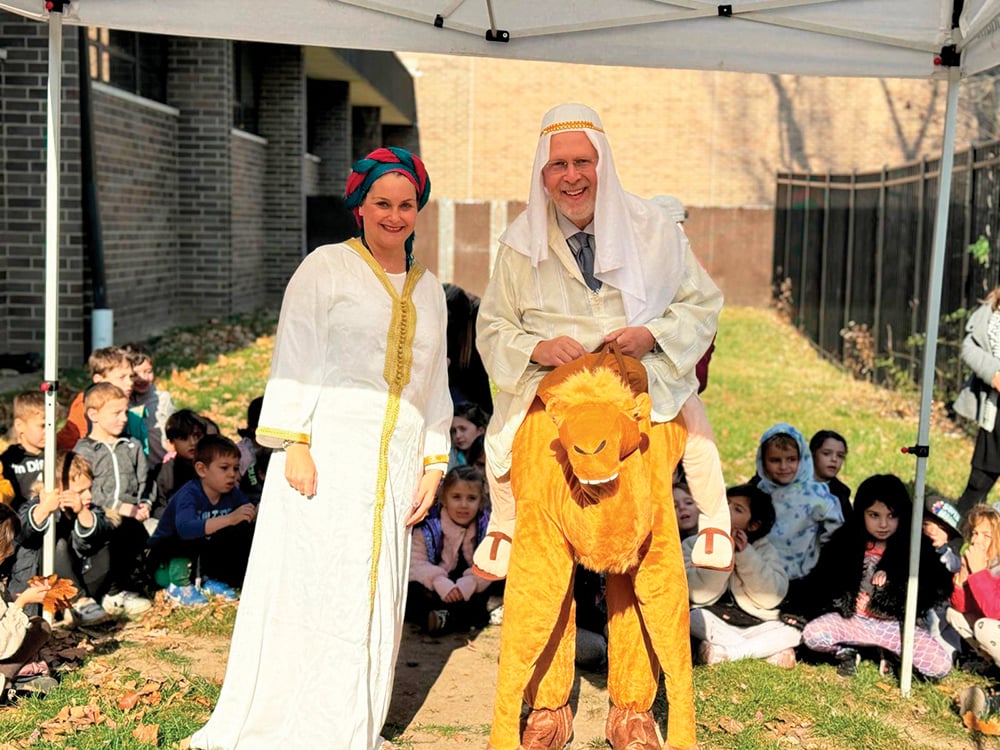A Unique Set of Pesukim
The events described in the Torah were written by Moshe Rabbeinu, exactly as transmitted from Hashem after those events occurred. For example, the meraglim incident was written after this incident, and the Korach rebellion was recorded in the Torah after it transpired. While there is a dispute (Gittin 60a) about whether the events of the Torah were recorded after each specific incident (Torah Megillah Megillah Nittenah) or only towards the conclusion of sefer Devarim and Moshe Rabbeinu’s life (Torah Chatumah Nittenah; all agree that Moshe Rabbeinu wrote the Torah up to the events of Har Sinai at Har Sinai—see Rashi to Shemot 24:4), all agree that the events were only recorded after each one occurred.
There are prophetic portions in the Torah, such as in Bilam’s blessings and the tochachot (sections of rebuke) at the end of sefer Vayikra and sefer Devarim. As noted by Rabbeinu Bachayei, these sections record events before they occur. However, the Torah clarifies these events will happen in the future. On the other hand, Moshe Rabbeinu’s death is presented in the past tense as having already occurred.
Hence, the last eight pesukim of the Torah (Devarim 34:5-12), which describe the death of Moshe Rabbeinu as having already happened, pose a serious difficulty. On the one hand, if Moshe Rabbeinu wrote these pesukim before his death, these pesukim differ from the entire Torah. On the other hand, it is axiomatic that the whole Torah was written by only Moshe Rabbeinu—as indicated in Devarim 31:24—which states that Moshe Rabbeinu wrote the words of the Torah “until their completion.” Could the last pesukim follow the pattern of the rest of the Torah and record the events only after they occurred but differ in that Moshe Rabbeinu did not write them?
The Tannaitic Dispute: Bava Batra 15a
The Gemara (Bava Batra 15a) records a major dispute among the Tanna’im about this issue. Rabbi Nechemiah argues that Yehoshua wrote these last pesukim, whereas Rabbi Shimon asserts that Moshe Rabbeinu wrote these pesukim as well (although he was crying while writing these pesukim.
Rambam (Hilchot Teshuva 3:8 and Hilchot Tefillah 13:6) rules strongly in favor of Rabbi Shimon, but Rashi (Devarim 34:5) cites both opinions. All opinions agree, however, that these pesukim—in some manner—differ from the rest of the Torah. This phenomenon even has halachic implications for the Torah reading on Simchat Torah, as noted by the Gemara (ibid.).
According to Rabbi Shimon and Rambam, these events are prophetic when written by Moshe Rabbeinu but are written in the past tense because they are “as good as done.” Some refer to this writing style as “prophetic past” and note that this phenomenon appears on occasion later in Tanach, such as in Yeshayahu 5:13, Iyov 5:20 and Divrei HaYamim II 20:37.
We suggest that even Rabbi Shimon and Rambam would agree that these last eight pesukim were not revealed to the entire Jewish people until after these events occurred. Thus, the pasuk (Devarim 34:9) that states that the Jewish people were obedient to Yehoshua after Moshe Rabbeinu’s death was not known to us until it occurred. It is possible that Moshe Rabbeinu wrote the last eight pesukim in the prophetic past before his death, but handed these pesukim to a very limited group of students who revealed these pesukim as Moshe Rabbeinu’s writing only after the events occurred.
Ibn Ezra’s Bold Opinion
Ibn Ezra occasionally presents daring approaches to pesukim that are at variance with Chazal in the narrative portions of the Chumash. For example, Ibn Ezra offers a peshat (straightforward explanation without the aid of midrashim) approach to Chumash, which often vary with Chazal’s midrashic approach to sections of Chumash that do not have direct halachic implications.
In Devarim, chapter 34 (pasuk 1), Ibn Ezra argues that Yehoshua wrote the entire perek after Moshe Rabbeinu’s death. Thus, Ibn Ezra extends Rabbi Nechemiah’s opinion and argues that the Torah’s last 12 pesukim were written by Yehoshua. Ibn Ezra is compelled by Devarim 34:1-4’s recording that Moshe Rabbeinu ascended Mount Nevo—apparently alone—where Hashem showed him Eretz Yisrael immediately before his death. Ibn Ezra notes that the pesukim do not record that Moshe Rabbeinu descended the mountain after this episode. Thus, Moshe Rabbeinu did not have the opportunity to record this event after it happened and then transmit it to Bnei Yisrael. Accordingly, Ibn Ezra concludes that Yehoshua also wrote the first four pesukim of perek 34 after the event. Ibn Ezra explains that Hashem presented Yehoshua with the information after the event. Otherwise, how could Yehoshua have known what happened after Moshe Rabbeinu ascended Har Nevo?
Rabbi Nechemiah could defend his opinion that Moshe Rabbeinu wrote the first four pesukim of perek 34 (although he believes that Yehoshua wrote the last eight) by arguing that Yehoshua accompanied Moshe Rabbeinu in his ascent to Mount Nevo. Support for this answer may be derived from Yehoshua being the sole individual who waited for Moshe Rabbeinu after he ascended Har Sinai to heaven (Shemot 32:17), and the halacha (Shulchan Aruch, Yoreh Deah 339:4) to make sure no one dies alone.
Another possibility is that after Hashem showed him Eretz Yisrael, Moshe Rabbeinu did descend from Har Nevo—to record this incident and transmit it to the Torah according to Hashem’s exact specifications. A third option is that Moshe Rabbeinu wrote the first four pesukim while on Har Nevo after being shown Eretz Yisrael, but before he died. Yehoshua later discovered the scroll written by Moshe Rabbeinu. This answer might be supported by Sefer Melachim’s recording (Melachim 2, 2:16-17) that after Eliyahu HaNavi died, his students scoured the area for his whereabouts. Yehoshua may have searched similarly for Moshe Rabbeinu’s body, at which point he discovered the scroll. There are, in fact, many parallels between Moshe Rabbeinu and Eliyahu HaNavi, making the comparison appropriate.
Ibn Ezra could respond to all of these suggestions that “ikar chaser min hasefer”—none of these suggestions are stated in the text. Rabbi Nechemiah and Rashi could reply that this is an example of “chisurei mechasra,”—the obvious need not be stated explicitly in the text when we could infer it independently.
Criticism of Ibn Ezra
The Ohr HaChayim (Devarim 34:9) severely criticizes Ibn Ezra’s approach. He argues that heresy sprouts from this approach, as it strengthens the heretical belief that the Torah has been edited and changed from its original state. The Ohr HaChayim emphatically endorses the opinion of Rabi Shimon and Rambam that Moshe Rabbeinu wrote all of the Torah, including the last eight pesukim.
One wonders why the Ohr HaChayim singles out Ibn Ezra for criticism, while not similarly criticizing Rabbi Nechemiah or even Rashi—who presents Rabbi Nechemiah as a viable option. After all, Ibn Ezra is simply expanding upon Rabbi Nechemiah’s opinion. One may respond that Ohr HaChayim is disturbed by Ibn Ezra’s venturing beyond where Rabbi Nechemiah and Rashi dared to tread. Rabbi Nechemiah and Rashi limit their approach to the pesukim, regarding which it seems impossible for Moshe Rabbeinu to have written during his lifetime.
Resolving an Apparent Inconsistency Within Ibn Ezra
Ibn Ezra appears to adopt a strikingly different tone in his grappling with Bereishit 36:31-39, which lists eight generations of kings of Edom “before a king reigned in Israel.” Ramban, Rashbam and Chizkuni all believe that the king of Israel described here is Moshe Rabbeinu. Ibn Ezra, though, cites an opinion that the king in Israel here is King Saul and that Bereishit 36:31-39 mentions—by prophetic means—kings not born yet during Moshe’s lifetime.
Ibn Ezra proceeds to quote a commentator—from the deviationist Karaite sect—who argued that these pesukim were written long after Moshe Rabbeinu’s death, during the reign of King Yehoshafat. Ibn Ezra sharply criticizes this view, “Heaven forfend, that the matter is like what he said about the days of Yehoshafat. His commentary deserves to be burnt.”
Why does Ibn Ezra embrace—and even expand upon—Rabbi Nechemiah’s opinion that a small portion of the Torah was not written by Moshe Rabbeinu, yet vigorously reject a notion that Bereishit 36:31-39 was written after Moshe Rabbeinu’s death? One may answer that the end of the Torah is a more fitting place to view as a codicil added to the end of the Torah, by the leading student of Moshe Rabbeinu after the latter’s death. In addition, it is acceptable to Ibn Ezra to claim that Yehoshua completed the Torah—since he was in the “same league” as Moshe Rabbeinu.
Chazal (Bava Batra 75a) compares Moshe Rabbeinu to the sun and Yehoshua to the moon. This statement captures the notion that although Yehoshua was a lesser prophet than Moshe Rabbeinu (as indicated by Devarim 34:10, which states that a prophet like Moshe Rabbeinu never arose amongst Israel), he is at least comparable to Moshe Rabbeinu. Moreover, Moshe Rabbeinu states (Devarim 18:15) that Hashem will send us a prophet “like me,” and Ibn Ezra interprets this as referring to Yehoshua. It cannot refer to other prophets since they cannot legitimately be compared to Moshe Rabbeinu.
Interestingly, Ibn Ezra interprets the phrase, “until this very day,” in Devarim 34:6 (which states that no one has discovered the location of Moshe Rabbeinu’s grave “until this very day”), as referring to the end of Yehoshua’s life. Ibn Ezra does not explain this pasuk—which could be understood to refer to a much later time—to refer to a time later than the death of Yehoshua. Thus, Ibn Ezra cannot countenance the idea of a pasuk being added to the Torah by someone other than Yehoshua.
Conclusion
While there is vigorous debate regarding the authorship of the last eight (and perhaps 12) pesukim in the Torah, there is no debate regarding the authorship of the rest of the Torah. Moshe Rabbeinu’s authorship of the rest of the Torah is a pillar of our belief, and Orthodox Judaism cannot countenance deviation—however minor—from this principle of faith. Orthodox Judaism, by definition, has “red lines,” and if one crosses them, he is no longer defined as Orthodox. As open as Ibn Ezra was to bold and innovative approaches within Chumash, his stern comments in his commentary to Bereishit 36:31 demonstrate that he had clear limits and boundaries beyond which he dared not cross.
Rabbi Jachter serves as the rav of Congregation Shaarei Orah, rebbe at Torah Academy of Bergen County and a get administrator with the Beth Din of Elizabeth. Rabbi Jachter’s 18 books may be purchased at Amazon and Judaica House.













